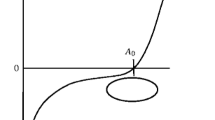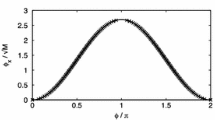Abstract
Differential equations are derived whose solution gives the cross-sectional shape of a flexible tube as a function of the transmural pressure. These equations are solved digitally to produce a series of closed curves, each curve representing the shape of a cross section for a particular set of conditions. These are then applied to the case of systemic arteries, pulmonary arteries, and large veins. The results predict that systemic arteries must always be circular, even when the internal and external pressures are equal. In veins, a small positive internal pressure causes them to become circular, regardless of their initial state, with negligible stretching. Further increases in internal pressure cause the area of the cross section to increase due only to stretching, the shape remaining essentially circular. With pulmonary arteries, known to be noncircular, changes in the cross-sectional area result from a combination of stretching and changes of shape.
Similar content being viewed by others
Literature
Attinger, E. O. 1969. “Wall Properties of Veins.”IEEE Trans. Biomed. Eng.,16, 253–261.
Bergel, D. H. 1972. “The Properties of Blood Vessels.” InBiomechanics. Its Foundations and Objectives, Eds Y. C. Fung, N. Perrone, and M. Anliker. Englewood Cliffs: Prentice-Hall.
Brower, R. W. 1970.Pressure-Flow Characteristics of Collapsible Tubes, Ph.D. Dissertation, Philadelphia, University of Pennsylvania.
Gow, B. S. and M. G. Taylor. 1968. “Measurement of Viscoelastic Properties of Arteries in the Living Dog.”Circ. Res.,23, 111–122.
Kresch, E. 1968.Design of a Nonlinear Electrical Model for Veins. Ph.D. Dissertation, Philadelphia, University of Pennsylvania.
Kresch, E. and A. Noordergraaf. 1967. “Theoretical Changes of Shape of Veins under Pressure.”Proc. Ann. Conf. in Med. and Biol. Vol. 9, Boston.
— and —. 1972. “Cross-sectional Shape of Collapsible Tubes.”Biophys.,12, 274–294.
Melbin, J., R. Gopalakrishnan and A. Noordergraaf. 1975. “Three Dimensional Laminar Flow in Distorting, Axisymmetric, Axially Varying Vessels.”Bull. Math. Biol.,27, 489–504.
Moreno, A., A. I. Katz, L. D. Gold and R. V. Reddy. 1970. “Mechanics of Distension of Dog veins and other very Thin-Walled Tubular Structures.”Circ. Res.,27, 1069–1080.
Patel, D. J. and J. S. Janicki. 1970. “Static Elastic Properties of the Left Coronary Circumflex Artery and the Common Carotid Artery in Dogs.”Circ Res.,27 149–158.
Rödenbeck, M. 1965. “Some Aspects of the Theory of Models of the Arterial and Venous Systems.”Proc. Ann. Conf. Eng. Med. Biol. vol. 7.
Author information
Authors and Affiliations
Rights and permissions
About this article
Cite this article
Kresch, E. Cross-sectional shape of flexible tubes. Bltn Mathcal Biology 39, 679–691 (1977). https://doi.org/10.1007/BF02461777
Issue Date:
DOI: https://doi.org/10.1007/BF02461777




